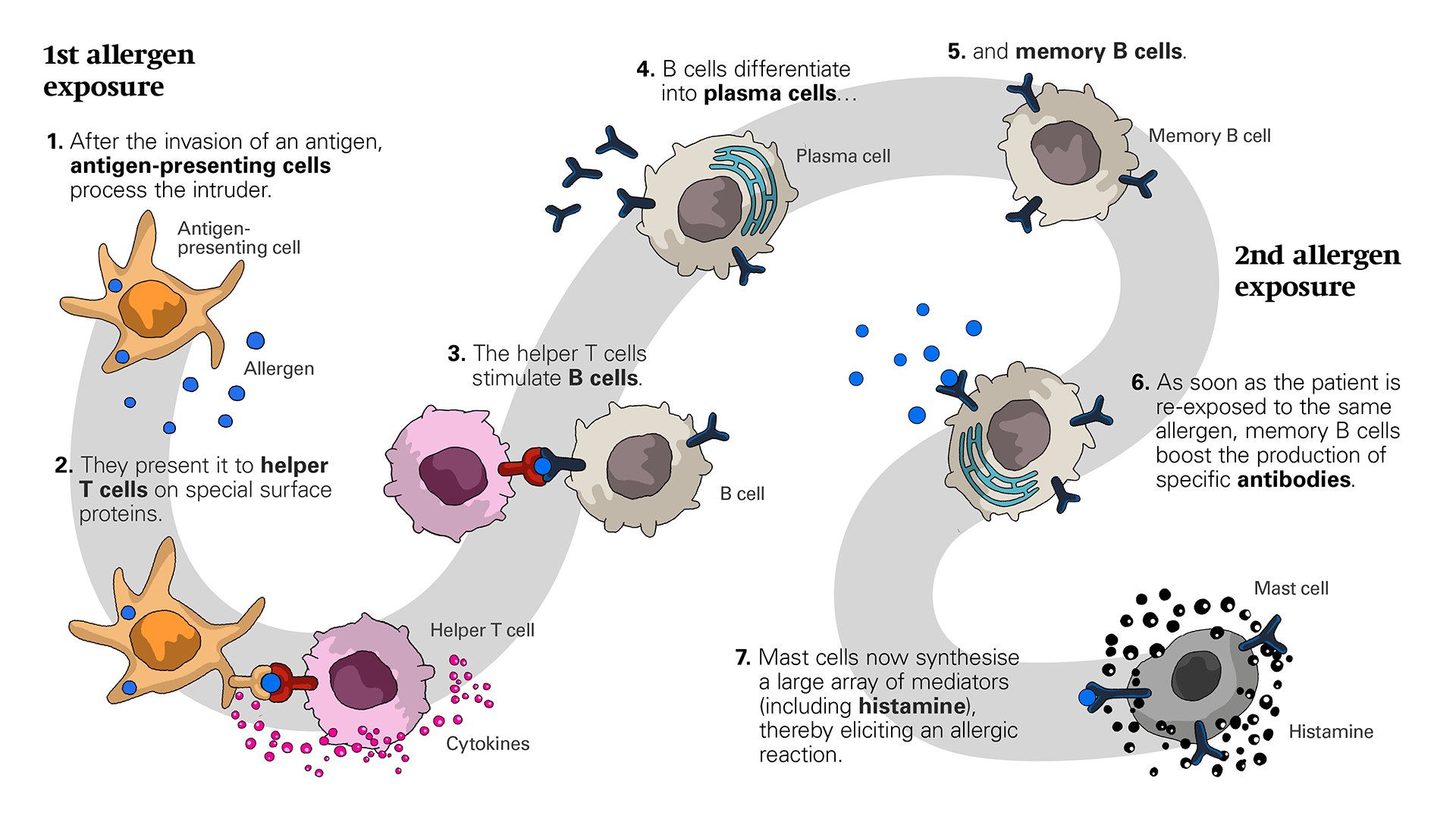IMMEDIATE MECHANISM: CLINICAL ALLERGIC DISORDERS
2.3
Mechanism of type I allergic reactions
The adaptive immune system is central in any immune defence, including allergic reactions. Before the body reacts to foreign intruders, it first has to encounter the antigen and identify it as potential danger. In allergies, the immune system produces an unnecessary, exaggerated defence reaction.
First allergen exposure
At the first allergen exposure, the patient may get sensitized. This step includes antigen presentation, the production of specific IgE antibodies, and their binding on mast cells or basophils. Allergic symptoms are only elicited if the sensitized patient is again exposed to the same allergen.
[
Development of immunological memory. (click to enlarge)
1. After the invasion of an intruder, antigen-presenting cells (APCs; ie dendritic cells or Langerhans cells) take up and process the antigen.
2. They then present it to T helper cells on special cell surface proteins. These proteins are called major histocompatibility complex (MHC) or human leukocyte antigen (HLA) molecules and represent an identification system present on all body cells (except on red blood cells and platelets) allowing to distinguish self from foreign.
3. The T helper cells then stimulate B cells.
4. The B cells turn into plasma cells and start to produce antibodies. Some antibodies bind to the surface of mast cells and basophils. A single plasma cell clone (family) produces large amounts of exact copies of just one specific antibody (eg IgG antibodies against a protein structure on a virus or IgE antibodies against a pollen protein). IgG antibodies are protective against microbes, IgE bound on mast cells against parasites.
5. Memory is established through memory B cells, which can again produce exactly the same antibody upon re-exposure to a given antigen. Such memory B cells will persist throughout life. Therefore, once sensitization has taken place, it will usually persist lifelong.
Sensitization takes about five to seven days and involves a number of complex steps, which are tightly regulated. But also damping or stopping the immune response, eg by T regulatory cells, is crucial. The immune system should not start to produce antibodies against the body’s own cells or organs and it should know when to stop – otherwise severe damaging inflammation or autoimmune diseases could occur.
Further allergen exposure
If the same allergen is encountered again, a specific immune response is triggered almost immediately. This process is much faster than the initial sensitization phase.
6. As soon as the patient is re-exposed to the particular allergen, memory B cells boost the production of specific antibodies.
7. The allergen further activates effector cells, such as mast cells and basophils. Mast cells are aligned in the skin, lung, and gut, while basophils are in circulation. Depending on the type of allergen and the ‘port of entry’, symptoms such as nettle rash (ie urticaria), bronchospasm (ie asthmatic attack), or intestinal symptoms occur. Mast cells and basophils synthesize a large array of pro-inflammatory mediators: chemokines, cytokines, histamine, leukotrienes, prostaglandins, and others. Among these, histamine is probably the best known. It may cause skin wheals, an itchy and running nose, tightening of the bronchi, and rapid bowel movements. These are altogether symptoms, which may help to eliminate the parasites in a protective immune response.
License
University of Basel
